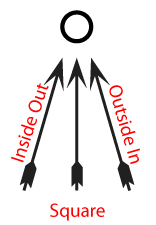Hey it’s Doc again with yet another no-cost video lesson to help you crush more long, gorgeous drives.
This week I want to talk about your right elbow, more specifically how getting your right elbow in the right spot during the downswing can add power and distance to your golf drives.
Bill McKinney’s baseball analogy in the video above is probably the best way I’ve ever heard this golf tip explained, that’s why I’m sharing it with you today. We’ve all seen those dramatic Sports Illustrated shots of a baseball pitcher just before he releases the ball with his hand so far behind his elbow it looks physically impossible. Pretty Impressive.
What does that have to do with golf? Well great pitchers and great golfers both know that they can maximize their speed by tucking their right elbow before the moment of truth. Why does this work for golf? Without getting into complex physics it basically loads up power in your swing. The more bent and pulled into your body your right elbow is, and the longer you can hold that position before impact, the more power you have to release right when you hit the ball.
When you tuck your elbow properly it’s like a loaded spring.
You may be thinking to yourself, well that’s great, but how the heck do I naturally get my elbow bent into my body like that? The answer is that although it looks awkward in slow motion it’s actually pretty easy to do when you are swinging.
However, if it doesn’t come naturally or you are having a hard time developing a feel for it you can have a buddy do what Billy is doing in the video with the student. By lightly grabbing a hold of the club as the student starts his downswing, Billy is forcing him to pull the club down and inward toward his body. In order to do this you will naturally tuck that right elbow into your body.
If you don’t have anyone willing to do this for you that’s okay, there’s a simpler way. To do this without a partner simply think about pulling the handle of the golf club downward and in toward your body from the top of your downswing. Just remember it’s not a jerking motion.
For more great power boosting tips from PGA Golf Pro Bill McKinney checkout his Natural Power DVD Package. You’ll be glad you did.
For Better Golf,
Doc O’Leary
Head Golf Nut OHP








 This week’s video tip is short but sweet. Check it out…
This week’s video tip is short but sweet. Check it out…


 Landing in a fairway bunker can be a stressful situation. The good news is that it doesn’t have to be. With the right tools and the right technique you can easily put yourself in a good position to save par or even have a shot at making birdie.
Landing in a fairway bunker can be a stressful situation. The good news is that it doesn’t have to be. With the right tools and the right technique you can easily put yourself in a good position to save par or even have a shot at making birdie.  Learning how to shape your golf shots (hit a draw or fade when you want to) is crucial if you want to take your golf game to the next level.
Learning how to shape your golf shots (hit a draw or fade when you want to) is crucial if you want to take your golf game to the next level.  The key is understanding the two key variables that affect where the golf ball goes. The first variable is the way the club approaches the ball (inside out, outside in, or square). The diagram to the right shows these angles in case you are having trouble visualizing this (note: the diagram on the right is for a right handed golfer, it would be opposite for lefties).
The key is understanding the two key variables that affect where the golf ball goes. The first variable is the way the club approaches the ball (inside out, outside in, or square). The diagram to the right shows these angles in case you are having trouble visualizing this (note: the diagram on the right is for a right handed golfer, it would be opposite for lefties).